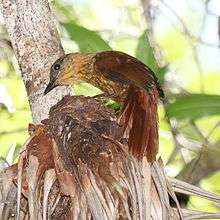Streak-breasted treehunter
| Streak-breasted treehunter | |
|---|---|
 | |
| Scientific classification | |
| Kingdom: | Animalia |
| Phylum: | Chordata |
| Class: | Aves |
| Order: | Passeriformes |
| Family: | Furnariidae |
| Genus: | Thripadectes |
| Species: | T. rufobrunneus |
| Binomial name | |
| Thripadectes rufobrunneus (Lawrence, 1865) | |
The streak-breasted treehunter (Thripadectes rufobrunneus), is a passerine bird which is endemic to the highlands of Costa Rica and western Panama.
This large treehunter is found in hills and mountains from 700 m up to 2500 m altitude, rarely to 3000 m, in damp epiphyte-laden forests and adjacent old second growth, especially in shady ravines. It builds a wide saucer nest of rootlets in a 60 cm long burrow in a steep bank, and lays two white eggs between February and August.
The adult streak-breasted treehunter is typically 21.5 cm long, weighs 54 g and has a stout black bill. It has a black-scaled dark brown crown and rich brown upperparts shading to rufous on the rump and tail. It has an ochre throat and otherwise tawny underparts which are streaked with ochre, especially on the breast. Young birds are paler with more extensive but less distinct breast streaking. The call is a loud zeck. The song is a buzzy chi-wawr, chi-wowr.
Streak-breasted treehunter is easily distinguished from its relatives by its large size, heavy bill and breast streaking.
The streak-breasted treehunter forages for large insects, spiders, amphibians and lizards in dense undergrowth and vines, searching through leaf litter, plant debris, bromeliads and other epiphytes for its prey. It is usually seen alone, but sometimes as part of a mixed-species feeding flock.
References
- ↑ BirdLife International (2012). "Thripadectes rufobrunneus". IUCN Red List of Threatened Species. Version 2013.2. International Union for Conservation of Nature. Retrieved 26 November 2013.
- Stiles and Skutch, A guide to the birds of Costa Rica ISBN 0-8014-9600-4
